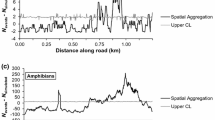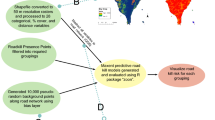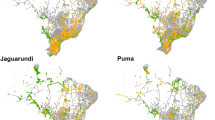Abstract
Context
Roads have several negative effects on large mammals including restricting movements, isolating populations, and mortality due to vehicle collisions. Where large mammals regularly cross roads, driver safety is also a concern. Wildlife road crossing structures are often proposed to mitigate the negative effects on wildlife and human safety. However, few studies have compared the efficacy of different methods in identifying wildlife road crossing and mitigation locations.
Objectives
We examined five commonly used methods to identify road crossing locations for wildlife to determine which method best captured empirical crossing locations.
Methods
We used GPS collar data on black bears in Massachusetts, USA, to estimate road crossing locations with a road crossing resource selection function, factorial least-cost paths, resistant kernels, Circuitscape, and an individual based movement model. We evaluated model performance on each road class and all road classes combined with a hold out road crossing data set.
Results
All methods performed well, but Circuitscape consistently outperformed the other methods, both for each road class and all road classes combined.
Conclusions
Road mitigation efforts for wildlife are often costly and have a long-term footprint on the landscape, therefore, it is important to select locations for these efforts that provide functional connectivity for wildlife. We are the first to compare different road crossing models for large mammals across a large study area and on different road types. Our results provide information to assist researchers and managers in selecting an analytical method for identifying potential road mitigation locations for large mammals.


Similar content being viewed by others
References
Adriaensen F, Chardon JP, De Blust G, Swinnen E, Villalba S, Gulinck H, Matthysen E (2003) The application of ‘least-cost’ modelling as a functional landscape model. Landsc Urban Plan 64:233–247
Anantharaman R, Hall KR, Shah VB, Edelman A (2019) Circuitscape in Julia: High performance connectivity modelling to support conservation decisions. arXiv:1906.03542
Balkenhol N, Waits LP (2009) Molecular road ecology: exploring the potential of genetics for investigating transportation impacts on wildlife. Mol Ecol 18:4151–4164
Bastille-Rousseau G, Wall J, Douglas-Hamilton I, Wittemyer G (2018) Optimizing the positioning of wildlife crossing structures using GPS telemetry. J Appl Ecol 55:2055–2063
Clevenger AP, Ford AT (2012) Wildlife crossing structures, fencing, and other highway design considerations. In: Safe passages: highways, wildlife, and habitat connectivity. Island Press
Clevenger AP, Huijser MP (2011) Wildlife crossing structure handbook: Design and evaluation in North America. Federal Highway Administration. Washington, DC. https://rosap.ntl.bts.gov/view/dot/41646
Clevenger AP, Wierzchowski J, Chruszcz B, Gunson K (2002) GIS-generated, expert-based models for identifying wildlife habitat linkages and planning mitigation passages. Conserv Biol 16:503–514
Compton BW, McGARIGAL K, Cushman SA, Gamble LR (2007) A resistant-kernel model of connectivity for amphibians that breed in vernal pools. Conserv Biol 21:788–799
Cushman SA, Lewis JS, Landguth E (2014) Why did the bear cross the road? Comparing the performance of multiple resistance surfaces and connectivity modeling methods|Treesearch. Diversity 6:844–854
Cushman SA, Lewis JS, Landguth EL (2013) Evaluating the intersection of a regional wildlife connectivity network with highways. Mov Ecol 1:12
Cushman SA, McKelvey KS, Schwartz MK (2009) Use of empirically derived source-destination models to map regional conservation corridors. Conserv Biol J Soc Conserv Biol 23:368–376
Dickson BG, Albano CM, Anantharaman R, Beier P, Fargione J, Graves TA, Gray ME, Hall KR, Lawler JJ, Leonard PB, Littlefield CE (2019) Circuit-theory applications to connectivity science and conservation. Conserv Biol 33:239–249
Fahrig L, Rytwinski T (2009) Effects of roads on animal abundance: an empirical review and synthesis. Ecol Soc 14:art21
Forman RTT, Sperling D, Bissonette JA, Clevenger CD, Cutshall VH, Dale L, Fahrig R, France CR, Goldman K, Heanue JA, Jones FJ (2003) Road ecology. Island Press, Washington
Gunson K, Mountrakis G, Quackenbush LJ (2011) Spatial wildlife-vehicle collision models: a review of current work and its application to transportation mitigation projects—ScienceDirect. J Environ Manag 92:1074–1082
Gustafson KD, Vickers TW, Boyce WM, Ernest HB (2017) A single migrant enhances the genetic diversity of an inbred puma population. R Soc Open Sci 4:170115
Huijser MP, McGowen PT, Fuller J, Ament R (2008) Wildlife-vehicle collision reduction study: report to congress. Western Transportation Institute, Bozeman
Ibisch PL, Hoffmann MT, Kreft S, Peer G, Kati V, Biber-Freudenberger L, DellaSala DA, Vale MM, Hobson PR, Selva N (2016) A global map of roadless areas and their conservation status. Science 354:1423–1427
Koen EL, Bowman J, Sadowski C, Walpole AA (2014) Landscape connectivity for wildlife: development and validation of multispecies linkage maps. Methods Ecol Evol 5:626–633
Landguth EL, Hand BK, Glassy J, Cushman SA, Sawaya MA (2012) UNICOR: a species connectivity and corridor network simulator. Ecography 35:9–14
Lewis JS, Rachlow JL, Horne JS, Garton EO, Wakkinen WL, Hayden J, Zager P (2011) Identifying habitat characteristics to predict highway crossing areas for black bears within a human-modified landscape. Landsc Urban Plan 101:99–107
Loro M, Ortega E, Arce RM, Geneletti D (2015) Ecological connectivity analysis to reduce the barrier effect of roads. An innovative graph-theory approach to define wildlife corridors with multiple paths and without bottlenecks. Landsc Urban Plan 139:149–162
McClure M, Ament R (2014) Where people and wildlife intersect: Prioritizing mitigation of road impactson wildlife connectivity. Center for Large Landscape Conservation. https://lccnetwork.org/resource/where-people-and-wildlife-intersect-prioritizing-mitigation-road-impacts-wildlife
McClure ML, Dickson BG, Nicholson KL (2017) Modeling connectivity to identify current and future anthropogenic barriers to movement of large carnivores: a case study in the American Southwest. Ecol Evol 7(11):3762–3772
McGarigal K, Compton BW, Jackson SD, Plunkett E, Rolih K, Portante T, Ene E, Jackson S, Compton B (2015) Conservation Assessment and Prioritization System (CAPS) Statewide Massachusetts Assessment. In: Landsc. Ecol. Program Dep. Environ. Conserv. Univ. Mass. https://www.umasscaps.org/data_maps/data.html. Accessed 26 Feb 2020
McRae BH, Dickson BG, Keitt TH, Shah VB (2008) Using circuit theory to model connectivity in ecology, evolution, and conservation. Ecology 89:2712–2724
McRae BH, Hall SA, Beier P, Theobald DM (2012) Where to Restore ecological connectivity? Detecting barriers and quantifying restoration benefits. PLoS ONE 7:12
McRae BH, Shah VB, Mohapatra TK (2014) Circuitscape 4 user guide. Version 4. The nature conservancy. https://www.circuitscape.org
Meza-Joya FL, Ramos E, Cardona D (2019) Spatio-temporal patterns of mammal road mortality in Middle Magdalena Valley, Colombia. Oecologia Australis 23(03):575–588
Osipova L, Okello MM, Njumbi SJ, Ngene S, Western D, Hayward MW, Balkenhol N (2019) Using step-selection functions to model landscape connectivity for African elephants: accounting for variability across individuals and seasons. Anim Conserv 22:35–48
Pastore M (2018) Overlapping: a R package for estimating overlapping in empirical distributions. J Open Source Softw 3(32):1023
Pastore M, Calcagnì A (2019) Measuring distribution similarities between samples: a distribution-free overlapping index. Front Psychol 10
Plunkett EB (2019) gridprocess: package for processing raster data. Version 0.1.3
Poor EE, Loucks C, Jakes A, Urban DL, Festa-Bianchet M (2012) Comparing habitat suitability and connectivity modeling methods for conserving pronghorn migrations. PLoS ONE 7(11):e49390
Proctor MF, Nielsen SE, Kasworm WF, Servheen C, Radandt TG, Machutchon AG, Boyce MS (2015) Grizzly bear connectivity mapping in the Canada-United States trans-border region. J Wildl Manag 79(4):544–558
Quaglietta L, Porto M, Ford AT (2019) Simulating animal movements to predict wildlife-vehicle collisions: illustrating an application of the novel R package SiMRiv. Eur J Wildl Res 65:100
R Core Team (2019) R: a language and environment for statistical computing. https://cran.r-project.org/. Accessed 6 Dec 2019
Rytwinski T, Soanes K, Jaeger JAG, Fahrig L, Findlay CS, Houlahan J, Van Der Ree R, van der Grift EA (2016) How effective is road mitigation at reducing road-kill? A meta-analysis. PLoS ONE 11:e0166941
Schuster R, Römer H, Germain RR (2013) Using multi-scale distribution and movement effects along a montane highway to identify optimal crossing locations for a large-bodied mammal community. PeerJ 1:e189
Seiler A, Helldin J-O (2006) (13) (PDF) Mortality in wildlife due to transportation. In: The ecology of transportation: managing mobility for the environment. Springer, New York, p 393
Tillé Y, Matei A (2016) sampling: survey sampling. Version 2.8. https://CRAN.R-project.org/package=sampling
Zeller KA, Jennings MK, Vickers TW, Ernest HB, Cushman SA, Boyce WM (2018a) Are all data types and connectivity models created equal? Validating common connectivity approaches with dispersal data. Divers Distrib 24:868–879
Zeller KA, McGarigal K, Whiteley AR (2012) Estimating landscape resistance to movement: a review. Landsc Ecol 27:777–797
Zeller KA, Wattles DW, Conlee L, DeStefano S (2019) Black bears alter movements in response to anthropogenic features with time of day and season. Mov Ecol 7:19
Zeller KA, Wattles DW, DeStefano S (2018b) Incorporating road crossing data into vehicle collision risk models for moose (Alces americanus) in Massachusetts, USA. Environ Manag 62:518–528
Zimmermann Teixeira F, Kindel A, Hartz SM, Mitchell S, Fahrig L (2017) When road-kill hotspots do not indicate the best sites for road-kill mitigation. J Appl Ecol 54:1544–1551
Acknowledgements
This work was supported by the Massachusetts Division of Fisheries and Wildlife through the Federal Aid in Wildlife Restoration program (W-35-R) and the Massachusetts Department of Transportation. We would like to thank L. Conlee, D. Fuller, M. Morelly, N. Buckhout, and other Massachusetts Division of Fisheries & Wildlife biologists, managers, and field technicians for assistance with field work as well as Massachusetts Cooperative Fish and Wildlife Research Unit technicians H. Moylan and J. Bonafini. We would also like to thank E. Plunkett for assistance with the gridprocess package and J. Bauder for assistance and providing code for the individual movement models.
Author information
Authors and Affiliations
Corresponding author
Additional information
Publisher's Note
Springer Nature remains neutral with regard to jurisdictional claims in published maps and institutional affiliations.
Electronic supplementary material
Below is the link to the electronic supplementary material.
Rights and permissions
About this article
Cite this article
Zeller, K.A., Wattles, D.W. & Destefano, S. Evaluating methods for identifying large mammal road crossing locations: black bears as a case study. Landscape Ecol 35, 1799–1808 (2020). https://doi.org/10.1007/s10980-020-01057-x
Received:
Accepted:
Published:
Issue Date:
DOI: https://doi.org/10.1007/s10980-020-01057-x




